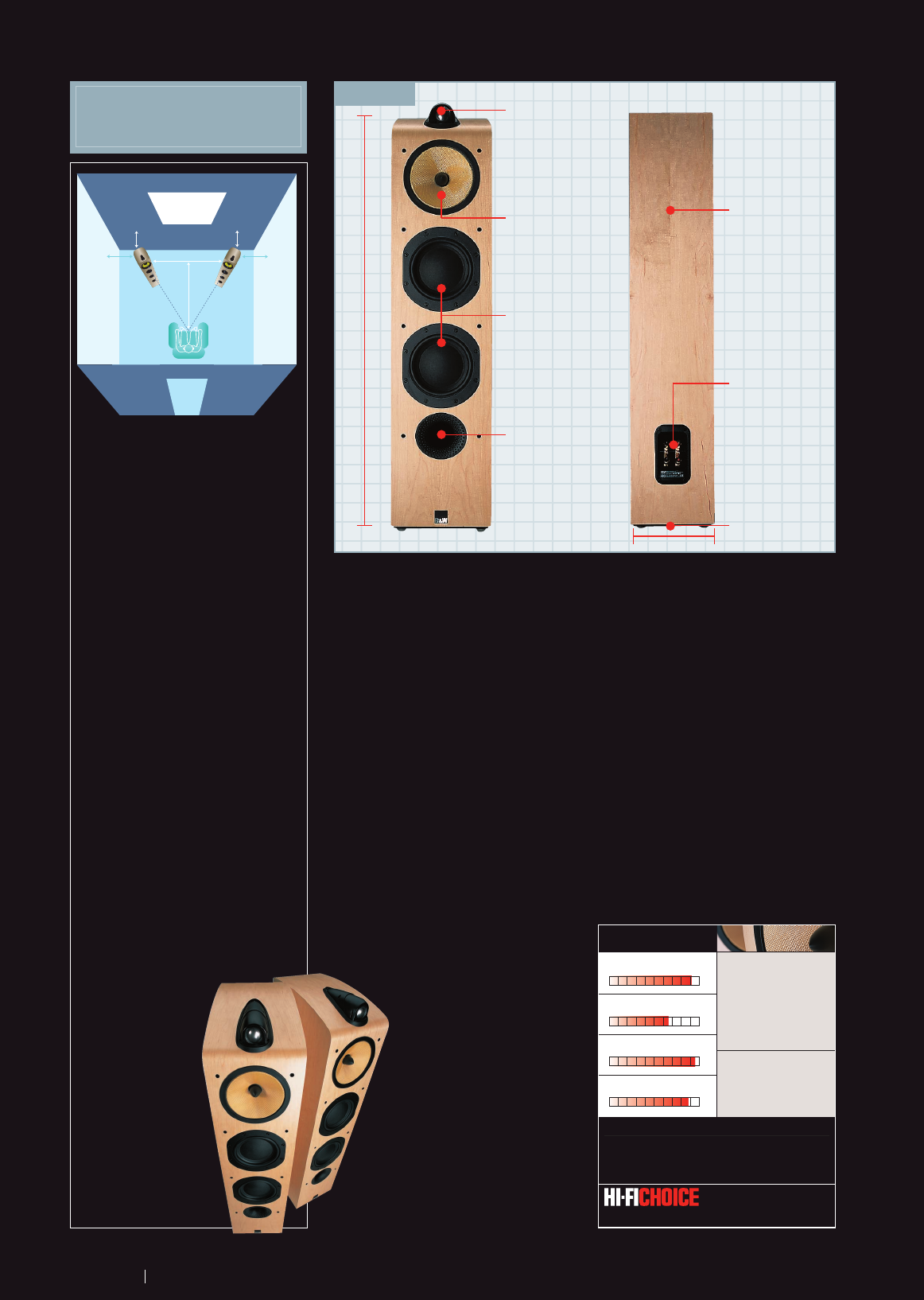
HI-FI CHOICE november2003
50
Once properly in the groove, the 703
showed some delightful characteristics, and
an overall standard of performance that
stands well out from the two-grand crowd.
There’s still arguably a touch too much
strength at the top end here – it’s certainly a
dB or two stronger than the 704 here, for
example – and this can occasionally prove a
trial with bright and edgy recordings,
especially if you want to play them loud. But
by the same token it often adds some
welcome extra ‘bite’ and clarity to the
musical proceedings.
It was interesting to have the 704 on hand,
and many will prefer the slightly warmer and
more laid-back balance and restrained treble
of the less expensive model (reviewed next
month). But direct comparison immediately
highlights the obvious superiority of the 703’s
FST midrange, which reproduces voices in
particular with much greater clarity and
expression, with a significantly wider dynamic
resolution window. It’s not entirely free
from coloration – there’s a certain
amount of nasality here – but it
is very expressive, and stereo
imaging is beautifully spacious
and superbly free from boxiness.
A very complex modern
composition involving several choirs
– Idmen, by Iannis Xenakis, since you
didn’t ask – came over the BBC
airwaves late one summer’s evening,
and the separation and clarity which the
703s brought to the complex vocal parts
was really quite transfixing. This is far from
familiar or indeed comfortable music for late
night listening, yet I was genuinely
disappointed when it finished.
If the midband is something a bit special,
the bass end is arguably even better. It’s dry,
clean, deep and even, all of which is quite
unusual and impressive. Even better, it’s very,
very fast and always agile, bringing truly
propulsive momentum and drive to a bass-led
album like the Easy Star All-Stars’ Dub Side Of
The Moon. Even an overblown recording like
Wyclef Jean’s The Carnival managed to sound
quite crisp and controlled – and very, very
clean and clear.
Do check first that this speaker’s slightly
cool, thin and bright balance suits your
personal taste and system. If it does, you’ll be
rewarded with a wonderfully analytical and
entertaining speaker, with superb agility and
an exceptionally wide dynamic range.
HFC
Paul Messenger
SOUND >> 91%
EASE OF DRIVE >> 66%
BUILD >> 95%
VALUE >> 88%
R
PRO
Classy floorstander has
artfully shaped enclosure and
very advanced drive units.
Superb imaging and an
exceptional dynamic range,
with expressive midband, and
fast, clean and deep bass.
S
CON
Sound is dry, cool and a touch
thin – the top end a mite
strong, giving a character
which can become aggressive.
CONCLUSION
Classy floorstander with very advanced drivers delivers superb
imaging and exceptional dynamic range, with a very expressive
midband and fast, clean bass, though its bright top end can
become aggressive when played loud.
OVERALL SCORE
89%
>>
VERDICT
Detail
101cm
23cm
‘Flowport’
reflex port
Alloy dome
tweeter is
mounted
externally,
coming with
its own loading
tube and grille
Enclosure slightly
narrower at rear
than front
Solid base
provides
secure spike
accommodation
Twin terminals
set nice and low,
for bi-wiring/
amping
POSITIONING
For the smoothest and most even bass delivery,
this speaker design ought really to be kept well
clear of walls if at all possible. If domestic
considerations dictate some wall proximity, bungs
are supplied to block up the ports. However, the
ports here are tuned to a low 35Hz, while
close-to-wall bass reinforcement occurs rather
higher up, in the 50-100Hz octave, so results are
unlikely to be smooth.
MEASURED PERFORMANCE
B&W’s claim for a 90dB sensitivity is fully justified
– even marginally pessimistic perhaps – but the
generous figure is compromised by a rather
demanding load, which hits a three-ohm
minimum at around 100Hz, which is a power-
hungry part of the spectrum, and remains low
between 80Hz and 350Hz.
The in-room far-field averaged responses look very
promising, however. With the speakers mounted
well clear of walls, and the ports left open, the
bass comes across as unusually smooth (+/-4dB
throughout, in spite of room modes), and also
very well extended (-3dB at 20Hz in-room). The
lower midband is a little lean, but strengthens
between 500Hz and 1.5kHz. The presence zone is
slightly recessed at 1.5-3.5kHz, but then peaks up
quite strongly at 4-6kHz, although these trends
are obvious enough, both in measurement and
audible terms.
SYSTEM MATCHING
Although this speaker has a
decent enough sensitivity,
the impedance dips to a
low three ohms in the
bass and lower
midband. It’s therefore
not really suitable for use
with lower power valve
amps such as single-
ended and direct-coupled
types, and is better
partnered with solid state
amplifiers that have
relatively generous current
delivery capabilities.
SET-UP
0.8-1m
0.8-1m
1-1.5m
1-1.5m
2-3m
3-4m
[
Review
]
B&W 703 loudspeaker
Q
165mm FST
(surroundless)
Kevlar cone
midrange driver
2x 165mm
paper/Kevlar
cone/dome
bass drivers
HFC247.bw 22/9/03 7:13 pm Page 50





